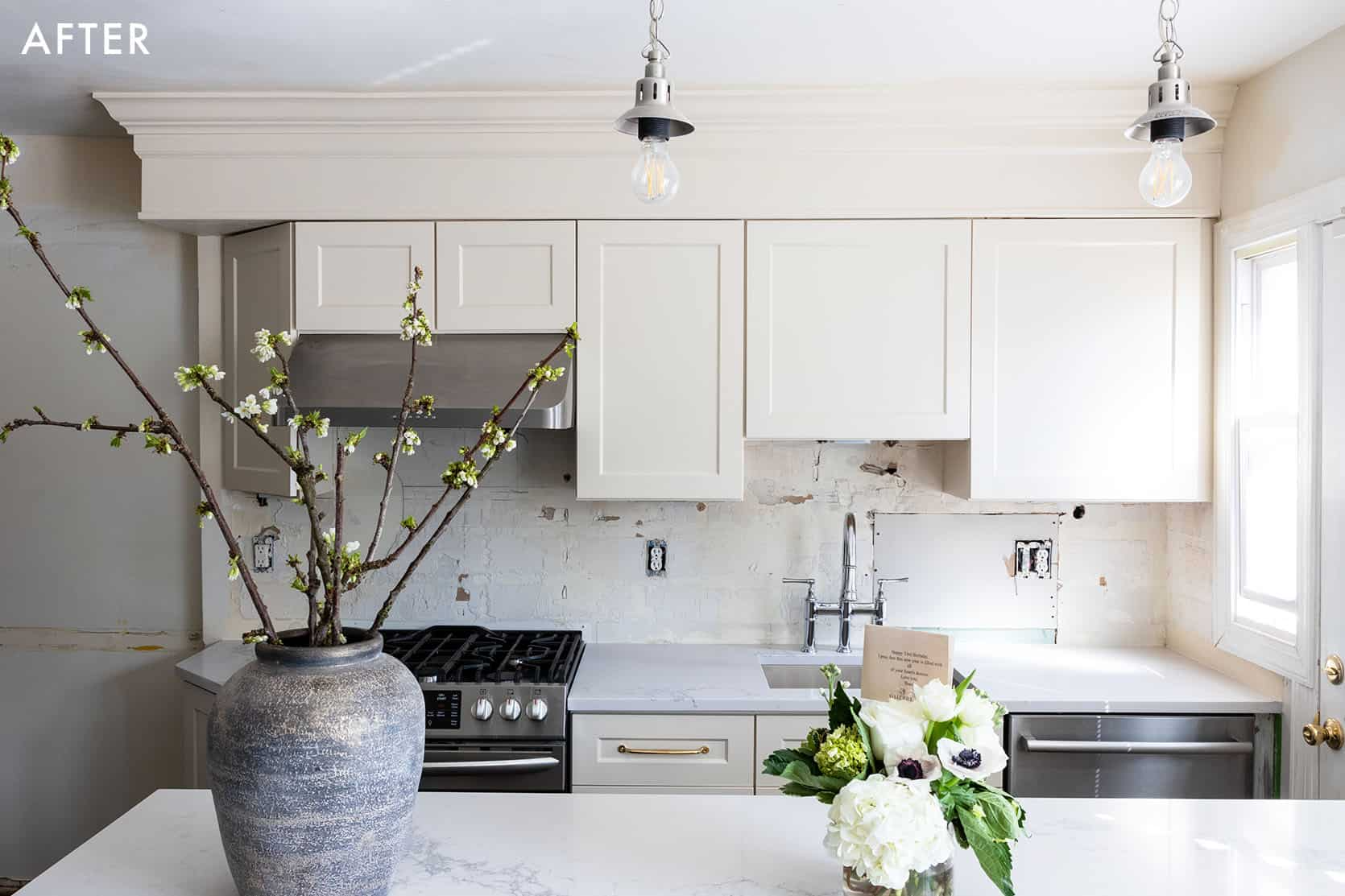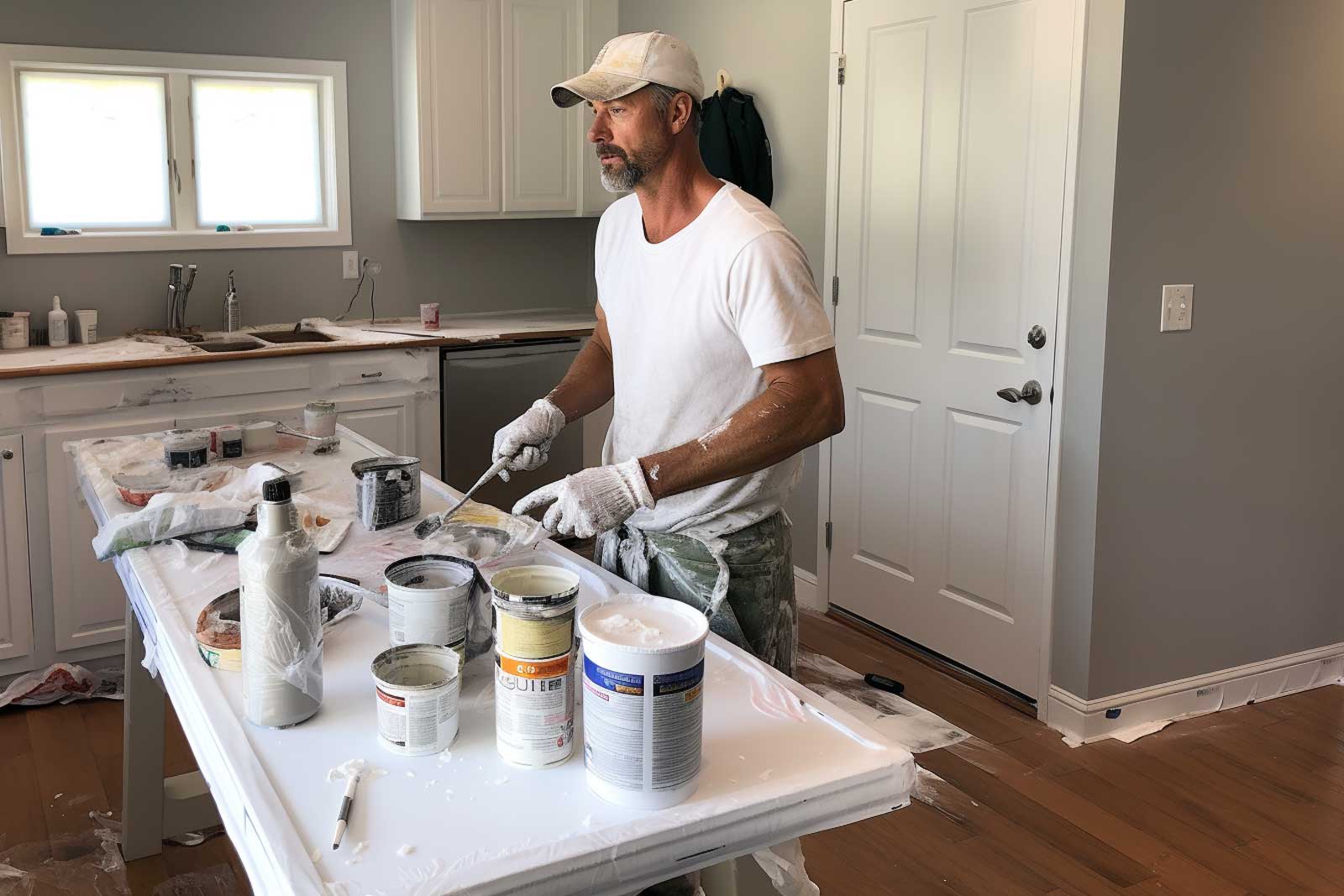Durability and Cleanability of Semi-Gloss Paint on Cabinets

Semi-gloss paint offers a compelling balance of aesthetic appeal and practical functionality for kitchen cabinets, particularly concerning durability and cleanability. Its higher sheen compared to satin or matte finishes provides enhanced resistance to scratches, chips, and stains, making it a popular choice for high-traffic areas like kitchens. This section will detail the performance characteristics of semi-gloss paint in comparison to other finishes, explore its stain and cleaning properties, and Artikel its long-term maintenance needs.
Comparison of Semi-Gloss Paint Durability with Other Finishes
Semi-gloss paint’s durability surpasses that of matte and satin finishes, primarily due to its higher resin content and smoother surface. Matte finishes, while offering a sophisticated look, are more susceptible to scratches and scuffs, showing wear and tear more readily. Satin finishes offer a compromise between gloss and matte, providing moderate durability, but still falling short of semi-gloss in terms of scratch and chip resistance. Gloss finishes, while highly durable, can accentuate imperfections in the underlying surface and appear overly shiny in some settings. Semi-gloss strikes a balance: offering excellent protection against everyday wear and tear while maintaining a visually appealing, less reflective surface compared to high-gloss options. For instance, a semi-gloss finish on kitchen cabinets would better withstand the impacts of frequently used drawers and doors compared to a matte finish, showing fewer signs of wear after years of use.
Semi-Gloss Paint’s Response to Stains and Cleaning Agents
Semi-gloss paint’s smooth, hard surface makes it relatively easy to clean. Spills and splatters, common in kitchens, can generally be wiped away with a damp cloth without leaving noticeable marks. However, stubborn stains may require a mild detergent and water solution. Avoid abrasive cleaners or scouring pads, as these can damage the paint’s finish. Oily stains, for example, are less likely to penetrate a semi-gloss surface than a matte finish, simplifying cleanup. Similarly, acidic substances like tomato sauce or lemon juice are less likely to etch or discolor a semi-gloss finish. The non-porous nature of the paint also prevents the absorption of stains, further enhancing its cleanability.
Cleaning Ease Comparison of Various Paint Sheens
| Finish Type | Stain Resistance | Cleaning Ease | Overall Durability Rating (1-5, 5 being highest) |
|---|---|---|---|
| Matte | Low | Difficult; stains may penetrate | 2 |
| Satin | Medium | Moderate; some stains may require scrubbing | 3 |
| Semi-Gloss | High | Easy; most stains wipe clean | 4 |
| Gloss | High | Easy; very durable and easy to clean | 5 |
Long-Term Maintenance of Semi-Gloss Painted Cabinets, Should cabinets be painted semi gloss
While semi-gloss paint offers superior durability, regular maintenance extends its lifespan. Minor scratches or chips can be addressed with touch-up paint, ensuring a consistent finish. Annual cleaning with a mild detergent and water solution is recommended to remove accumulated grease and grime. More frequent cleaning may be necessary in high-use areas. Repainting frequency depends on usage and environmental factors; however, with proper care, semi-gloss painted cabinets can last for many years before requiring a complete repaint. For example, a kitchen with frequent cooking and high humidity may require repainting every 7-10 years, while a less frequently used kitchen might only need repainting every 10-15 years. Regular cleaning and prompt attention to minor damage significantly prolong the life of the paint job, minimizing the need for frequent and costly repainting.
Aesthetic Considerations for Semi-Gloss Cabinet Paint

Semi-gloss paint offers a unique aesthetic contribution to kitchen cabinetry, impacting the overall visual perception through its light-reflective properties and interplay with various cabinet styles. The sheen level significantly influences how light interacts with the surface, altering the perceived color, depth, and texture of the cabinets. Understanding these interactions is crucial for achieving the desired aesthetic outcome.
Light Reflection and Semi-Gloss Cabinetry
The impact of light on semi-gloss painted cabinets is multifaceted, varying significantly depending on the lighting source. In bright lighting conditions, such as those found in kitchens with ample overhead lighting or large windows, the semi-gloss sheen enhances the vibrancy of the cabinet color. The reflective surface creates a sense of luminosity, making the cabinets appear more polished and visually striking. However, harsh reflections might also be observed, potentially highlighting imperfections. In dim lighting conditions, the semi-gloss finish still offers a noticeable sheen, preventing the cabinets from appearing dull or flat. The reflective properties, while less pronounced, maintain a level of visual interest, adding depth without overwhelming the space. Natural light, with its varying intensities and warm tones, provides a more nuanced interaction with the semi-gloss finish. The cabinets will appear to subtly shift in color and brightness throughout the day, creating a dynamic and visually appealing effect. However, direct sunlight might lead to noticeable glare.
Comparison of Semi-Gloss with Other Sheens on Various Cabinet Styles
Semi-gloss paint provides a happy medium between the high-gloss and matte finishes. High-gloss paint offers a mirror-like reflection, which can be visually stunning on sleek, modern slab-door cabinets. However, this high reflectivity can also highlight imperfections and feel overly formal in some kitchen styles. Conversely, matte or eggshell finishes offer a softer, more subdued look, ideal for traditional raised-panel cabinets, creating a sense of warmth and texture. These finishes, however, tend to show fingerprints and smudges more readily. Semi-gloss provides a balance: the sheen adds depth and elegance without the excessive glare of high-gloss, while its durability surpasses that of matte finishes. On shaker cabinets, the semi-gloss finish highlights the clean lines and recessed panel details, creating a refined and sophisticated look. The subtle sheen adds visual interest without detracting from the cabinet’s design. On slab-door cabinets, semi-gloss creates a contemporary feel, less stark than high-gloss but more polished than matte. Raised panel cabinets benefit from the depth and dimension added by the semi-gloss sheen, which accentuates the carved details without overwhelming the overall design.
Visual Representation of Cabinet Styles with Semi-Gloss Paint
To illustrate the visual impact, consider these text-based representations:
Shaker Cabinets: Imagine clean, straight lines with a recessed center panel. The semi-gloss paint subtly reflects light, emphasizing the crisp edges and creating a sense of refined elegance. The color appears rich and vibrant due to the reflective properties of the paint.
Slab Cabinets: Picture a simple, flat-panel door. The semi-gloss paint provides a sleek, modern look, offering a subtle sheen that avoids the harsh reflections of high-gloss. The uniformity of the surface is accentuated, creating a minimalist and sophisticated aesthetic.
Raised Panel Cabinets: Envision detailed molding and raised panels. The semi-gloss paint enhances the three-dimensionality of the design, highlighting the texture and detail of the panels. The subtle sheen adds depth and elegance, creating a traditional yet updated look.
Practical Aspects of Painting Cabinets Semi-Gloss: Should Cabinets Be Painted Semi Gloss

Successfully painting kitchen cabinets semi-gloss requires meticulous preparation and application. The final result, a durable and attractive finish, hinges on careful attention to detail throughout the entire process. Ignoring even seemingly minor steps can lead to an uneven finish, chipping, or premature wear.
Should cabinets be painted semi gloss – Proper preparation is paramount to achieving a professional-looking, long-lasting semi-gloss finish on kitchen cabinets. This involves several crucial steps that ensure the paint adheres properly and provides optimal durability. Failure to complete these steps thoroughly can compromise the final result.
Cabinet Preparation for Painting
Thorough preparation is the foundation of a successful paint job. The following steps ensure a smooth, even surface for optimal paint adhesion and a professional finish. Each step plays a critical role in the longevity and appearance of the final product.
- Cleaning: Begin by thoroughly cleaning the cabinet surfaces to remove grease, grime, and any existing finishes. Use a degreasing cleaner and a soft cloth or sponge, paying attention to all crevices and details. Allow the cabinets to dry completely before proceeding.
- Sanding: After cleaning, lightly sand the cabinet surfaces using fine-grit sandpaper (180-220 grit). This creates a slightly rough surface that helps the primer and paint adhere better. Focus on smoothing out any imperfections and removing any remaining glossy residue from the old finish. Always sand in the direction of the wood grain to avoid scratches.
- Priming: Apply a high-quality primer specifically designed for cabinets. This is crucial for ensuring good adhesion, blocking stains, and providing a uniform base for the semi-gloss paint. Use a brush or roller to apply a thin, even coat, allowing it to dry completely before painting.
Semi-Gloss Paint Application Techniques
The application method significantly impacts the final finish. Using the correct tools and techniques ensures a smooth, even coat, free from brushstrokes or roller marks. Different application methods offer varying levels of control and finish.
Several methods exist for applying semi-gloss paint to cabinets, each with its own advantages and disadvantages. The choice depends on factors such as the size of the project, desired level of finish, and the painter’s skill level.
- Brush Application: A high-quality angled brush, specifically designed for painting, allows for precise application, especially in corners and detailed areas. Use smooth, even strokes, avoiding overloading the brush with paint to prevent drips and runs. Multiple thin coats are preferred over one thick coat.
- Roller Application: A short-nap roller is ideal for achieving a smooth finish on larger cabinet surfaces. Use a roller tray to load the roller evenly, applying the paint in smooth, overlapping strokes. Work in small sections to avoid lap marks.
- Spray Application: Spray application provides a very smooth, even finish, particularly beneficial for large projects. However, it requires specialized equipment, proper ventilation, and experience to avoid overspray and runs. Use a high-quality spray gun and follow the manufacturer’s instructions carefully.
Should Cabinets Be Painted Semi-Gloss?
The decision of whether to paint cabinets semi-gloss depends on individual preferences and the overall style of the kitchen. Semi-gloss paint offers several advantages. Its durability makes it highly resistant to scratches and moisture, crucial for high-traffic areas like kitchens. The easy cleanability is a significant benefit, as spills and smudges wipe away effortlessly. However, semi-gloss paint also highlights imperfections more readily than matte or eggshell finishes. Careful preparation is therefore essential to achieve a flawless result. The sheen level also contributes to the overall aesthetic of the space. A semi-gloss finish reflects light more than a matte finish, brightening the kitchen and creating a more modern feel. Conversely, it can accentuate imperfections more noticeably. Ultimately, the choice hinges on balancing the desired level of durability and cleanability against the potential for highlighting surface flaws. Careful consideration of these factors will lead to an informed decision that best suits your needs and aesthetic preferences.
